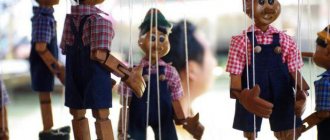Danger of disease
Being afraid of something or someone is a normal property of the psyche. But, if this feeling takes on a pathological character, then it can lead to various problems.
Important! The development of the disease can be gradual and unnoticed.
Worry and worry make it difficult to lead a normal life. In severe cases, problems develop with the nervous and cardiovascular systems. Constant neuroses will lead to an early heart attack.
In severe cases, the phobia may be accompanied by obsessive-compulsive disorder. With it, a person becomes fixated on performing rituals that should protect him from harm.
Symptoms of nyctophobia
How do you understand that you have a phobia, and not just a developed sense of self-preservation? After all, to one degree or another, we are all a little afraid of dark streets or basements, and not without reason.
An ordinary person in a dark room will experience only a slight feeling of discomfort, maintain clarity of mind and logic of actions. while the irrational fear of the dark plunges a person into panic. A nyctophobe literally ceases to be aware of his actions - to the point of panicking to where there is light.
Symptoms of phobic fear, pathological fear manifest themselves in human behavior and psychology, as well as physiologically.
Social and psychological manifestations:
- fear of being alone at home in the dark - often such people turn on the TV and can only fall asleep listening to it;
- strong, inadequate fear of dark streets, unlit alleys of parks - a nyctophobe considers them extremely dangerous;
- panic attack when turning off the lights or entering a dark room;
- feeling of despair, hopelessness;
- loss of control (flight to the light);
- the various rational explanations that a phobia sufferer comes up with for their fear; non-acceptance of the existence of a phobia;
- various rituals that a nyctophobe performs in order to prevent imaginary threats emanating from the darkness, fear of violating these rituals.
Physiological manifestations that a nyctophobe may experience during an attack:
- a sharp increase in blood pressure;
- increased heart rate;
- sudden muscle weakness;
- trembling hands, general shaking or chills;
- headache;
- loss of voice;
- stomach ache.
Types of phobias
Fear of dolls - what is this phobia and what is it called?
Each pathological fear may have its own characteristics. Not everyone knows about the fear of mice, what this phobia is called. Psychologists call this disorder musophobia. With it, a person experiences fear only of mice, both wild and ornamental.
Sometimes the fear of rats is called suriphobia. In this case, a person is afraid only of large rodents; the rest do not cause him concern. Any phobia can manifest itself in varying degrees. Some people find it unpleasant to see live animals, while others find it unpleasant even to see pictures or stills from films.
You may come across the name zemmiphobia. The disorder is characterized not only by fear of mice, but also of any rodents: voles, moles and others.
The fear of bats is called chiroptophobia. This condition is characterized by aversion to only one type of animal. A person can perceive the rest normally.
Phobias are often combined with each other. Therefore, you should not neglect their development, as they can lead to serious health problems.
Origin of the definition of zemmiphobia
You may be interested in: Schizophrenia in adolescents: symptoms, diagnosis and treatment
Zemmiphobia (in other sources - zemmiphobia) stands for "fear of large mole rats." Some researchers have become interested in the question of what it is.
The popular version is the popular name for naked rats, which in appearance and behavior are practically no different from moles. The only difference is that on the front of their heads they have pronounced fang-shaped teeth, with which they dig underground tunnels. They live in groups in Africa. Each of these colonies numbers from 80 to 300 animals. Among them there is only one main female, and her males include 19 individuals. Other members of the colony perform work tasks or simply provide security.
But it has not yet been confirmed by significant evidence. Therefore, if it contains erroneous information, then science does not yet know where the word “zemmiphobia” came from.
Symptoms of manifestation
Fear of dogs - what is the name of the phobia?
The fear of rats and mice does not immediately turn into a phobia. The first signs appear upon direct contact with rodents. At the sight of them, a person becomes stiff, numb and experiences a panic attack.
Even if the mouse is sitting and has no intention of coming, it still causes fear
If a person encounters a rodent in the house, then he begins to constantly look for traces of the animal, set traps and be afraid to be in a dark room.
Important! In some cases, a person begins to feel that there is a persistent smell of a mouse in the room.
Any rustle will provoke anxiety. Even having a cat at home will not calm the patient. The peculiarity of the fear of rodents is that a person cannot rationally explain his fear.
In psychology, there are two groups of symptoms: behavioral and physiological. The first is characterized by a feeling of anxiety, an obsessive desire to look for a rodent, etc.
The second is characterized by manifestations from the body:
- Cardiopalmus;
- Increased sweating;
- Nausea;
- Vomit;
- Dizziness;
- Headache and others.
As your fear of rodents progresses, your symptoms will intensify. In severe cases, it can lead to complete inability to lead a normal life.
Musophobia can be called a modern disease, since due to the abundance of landfills, rats and mice live quietly in the city. You can encounter them every day.
What is the fear of mice and rats called?
The fear of mice and rats has a scientific name - zemmiphobia: fear of rats, mice, and moles. It is believed that the name zemmiphobia comes from the popular name for large rats that resemble moles. They have large fangs with which they dig tunnels.
Types of phobias
Fear of rats and mice is a common phobia, and it has several varieties.
- Suriphobia. This term refers to the fear only of rats. People treat other rodents calmly.
- Musophobia. This is what they call the fear of mice. This name is often used as a generic name for rodent fear.
- Chiroptophobia. The term is used to refer to the fear of bats. This fear often stems from the influence of vampire films.
Reasons for appearance
Fear of clowns - what is this phobia and what is it called?
It is normal to experience unpleasant feelings when you see rodents. They are carriers of various diseases. Therefore, subconsciously a person tries to avoid meeting them.
Important! A phobia often develops after a traumatic situation.
If a child is attacked by a rat or mouse, he will begin to fear history repeating itself. Sometimes children hear a squeak in the dark and they turn on the light. In this case, they may see rodents in the room or on the crib. This picture can be very scary.
The phobia is not always observed from childhood. It can also appear in an adult. For example, a woman wants to take some grains from a bag of cereal and stumbles upon the carcass of a dead mouse or sees an animal in the kitchen.
Sometimes rats attack people, this can happen in a summer cottage. A person may not notice the animal and step on it. After such a collision, pathological fear appears.
In urban environments, there is also a chance of encountering rodents. They live near garbage dumps, in landfills and calmly walk from house to house. Few people enjoy such a neighborhood.
Impressionable individuals who are prone to hypochondria may take information about infectious diseases too seriously. Rodents carry many types of them: from rabies to parasites. Therefore, any thought about meeting them causes panic.
Both women and men are susceptible to phobias
Pathological fear of mice can develop against the background of other problems. With a high level of anxiety, every little thing is perceived sharply and negatively.
Symptoms, signs and manifestations of phobia
Phobias manifest themselves differently in everyone, but there are some general signs:
- cardiopalmus;
- rapid breathing;
- dry mouth;
- increased sweating;
- trembling in the limbs.
Some people experience terrible fear when they see a rodent and cannot move. When you see a rodent, you may feel a sense of unreality.
It’s not easy for Musophobes who understand the groundlessness of their own fear. They realize that mice are safe for them and will not attack, but they still cannot control themselves when they see a rodent. Men with such phobias are afraid that others will find out about their fear. Fear of shame in front of others can lead to depression.
An advanced form of zemmiphobia may be accompanied by a gag reflex at the sight of rodents. There may also be obsessive fantasies, a feeling that rodents are everywhere, and a constant expectation of an attack.
How to deal with the problem
Treatment of fear consists of two components: medication and psychotherapy. Pills, tranquilizers and antidepressants are prescribed only in severe cases when physical symptoms need to be relieved.
With the help of medications you can reduce the level of anxiety, worry, and worry. A person will not even notice how he will cease to be afraid of every rustle and vague shadow on the floor. In this state it will be easier for him to undergo psychotherapy.
The specialist helps the patient analyze his life, find the reason for the development of the phobia and get rid of it. With this you can radically change your attitude towards the situation.
Important! Psychotherapy can take several months; it is not a quick fix.
In some cases, a specialist can gradually accustom a person to the subject of fear. Show videos or pictures of mice. Gradually, the contact time increases, and the patient begins to calmly perceive rodents.
Self help
Sometimes a person with musophobia has to use meditation or auto-training. These two methods help reduce the level of panic, calm down, and collect your thoughts.
Techniques like these are needed for quick help.
To relieve stress, you can watch cartoons with mice or funny videos. The main thing is to understand that rodents are not dangerous and can be quite cute and funny. Many owners of such animals make videos with tricks and post them on the Internet.
Musophobia is called one of the most common problems. Due to the large number of rodents in cities, people are increasingly encountering them. All this leads to all sorts of problems.
How to get rid of fear
You can get rid of the fear of rodents at home, if the symptoms are not very pronounced. For this, viewing pictures of rodents or videos in which mice are the main characters are suitable.
Serious manifestations of fear require correction by a psychotherapist and the use of special medications . Let's look at the main ways to combat panic in front of rodents.
Visual therapy
To overcome a superficial fear of mice, viewing pictures or detailed study of information about them: their halo and structural features of rodents will allow you to overcome them. For a closer acquaintance with the animal, scientific and entertainment films and programs are suitable.
The best effect in fear therapy can be achieved by caring for a rodent at home. Pet stores provide a wide range of house mice that get along well with people and feel comfortable in captivity. Mice can become pets just like cats or dogs.
Important! A person who is afraid of mammals should force himself to look at them as often as possible. Residents of rural areas are much easier on mice, due to the fact that they see them much more often than city dwellers.
A person suffering from a significant phobia can take loved ones with him to the pet store. At the same time, you need to monitor the behavior of the object of your fear and imagine funny stories with their participation in your head.
If the phobia is significant, you should consult a psychiatrist. He will tell you how to stop being afraid of mice and rats.
Video
How to stop being afraid of rats?
Comparison of mouse and rat
A child may develop an unwanted fear of mice due to the violent reaction of adults to the sudden appearance of an animal. Most often, a person’s fears originate from childhood, when the psyche is not fully formed.
To eliminate musophobia, a comparative analysis can be carried out between mice and rats. The fear of rats is justified because animals cause real harm to humans: they not only spread infectious diseases, but also harm households. Mice are shy animals and will prefer to hide when they see the owner of the room.
External differences between mice and rats are also considered to reduce the intensity of fears of rodents. Often, aversion to mice is due to the fact that they are associated with rats, which have bare tails, huge teeth and bulging eyes.
Mice are very different in appearance from their larger relatives. They also cannot move along a vertical plane (walls, ventilation, telephone lines). A rat bite can lead to serious illness and a number of unpleasant consequences. A mouse can only bite if there is an immediate threat to its life.
Getting a domestic cat
Mice and rats try to avoid houses that have domestic cats. This fact can be used to eliminate signs of musophobia. Cats, especially those that walk outside, can quickly track down mice and destroy them.
There is another good way to stop being afraid of mice if there is no cat in the house. Instead of a repeller, you can use animal litter. Cat urine is also effective on rodents.
Phobias of famous people
The outstanding commander Napoleon , who won many battles, was afraid of cats and white horses. When Napoleon was only six months old, the nanny who cared for him left him alone in the garden and a stray cat jumped on the child. Probably at that moment the cat seemed like a huge lion to the six-month-old baby. Fear remained with the emperor for the rest of his life. The fear of cats is called ailurophobia.
In addition, Napoleon was afraid of white horses. The paintings where the emperor sits on a white horse are just an image created by the artist’s imagination.
pixabay.com/en
Adolf Hitler was so afraid of dentists that he preferred to suffer in pain. Due to dental phobia , the Fuhrer often had toothaches, bad breath, his teeth turned yellow early, and he suffered from abscesses and gum disease.
Genghis Khan was very afraid of dogs.
The famous writer Nikolai Gogol was afraid all his life of being buried alive ( taphophobia ). Gogol even made a special will: he was to be buried only when signs of decomposition appeared.
Director Alfred Hitchcock never tried eggs in his life - they were disgusting to him ( ovophobia ). He said that there is nothing more disgusting than these white round things without holes with a yellow substance inside.
pixabay.com/en
Peter I was a brave warrior. However, he was terrified of... cockroaches ( blattophobia ). The king did not enter the house until one of his servants examined all the chambers and made sure that these insects were not there.
Many psychologists and psychotherapists tried to analyze the behavior of Joseph Stalin The Soviet leader was afraid of being poisoned ( toxicophobia ), of air travel ( aerophobia ), and was also very afraid of going to bed ( somniphobia ).
It is known that the famous football player David Beckham is obsessed with order and symmetry. He has ataxophobia , a disorder in which everything must be in its place, arranged by shelves and colors, and also by size, and so on.
Ways to deal with a phobia
You can try visiting stores that stock those types of animals that a person is afraid of.
It is common for all people to be afraid of rats and mice, but this is normal only until a phobia or pathological fear develops. It is possible and necessary to fight a phobia, both on your own and with the help of psychotherapy.
You can overcome a phobia on your own at the initial stage of development. This is where auto-training and a thorough study of the habits of the object of fear come to the rescue. So, a person must convince himself that a mouse or rat is not dangerous for him, since it itself is much more afraid of it. A person needs to understand that all diseases carried by rats can be successfully treated, and in general it is unlikely to meet this small animal in a city apartment.
Some psychologists recommend starting with trips to the zoo or pet stores that stock tame rats and mice. Looking at these animals can help overcome fear. Interestingly, many former zemmiphobes who have managed to overcome their phobia eventually begin to keep mice, tame rats and other small rodents as pets.
Professional help
If a person doubts his own abilities, it is recommended to consult a psychotherapist. In general, zoophobia can be treated quite successfully, and fear of mice and rats is no exception.
The most commonly practiced method is gradual rapprochement with the object of fear in conjunction with cognitive behavioral psychotherapy. First, the doctor and the patient form a different view of rodents, and then the patient is shown getting closer to the animal. To begin with, the patient is recommended to watch movies and cartoons about mice and rats, then the doctor brings a mouse in a cage into the office, ensuring that the patient gets used to the presence of a rodent. After a few more sessions, the zemmiphobe should pet the rodent and pick it up. In the vast majority of cases, 10-12 sessions of psychotherapy are enough to ensure that not a trace remains of the phobia.











